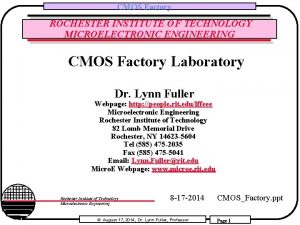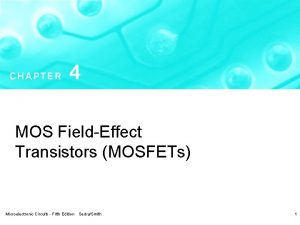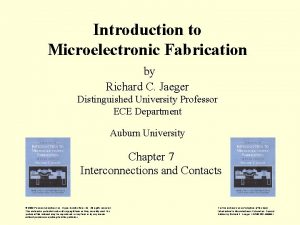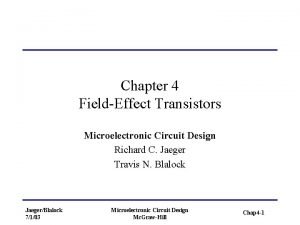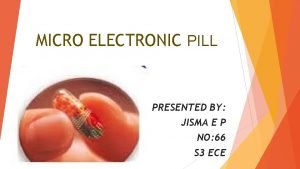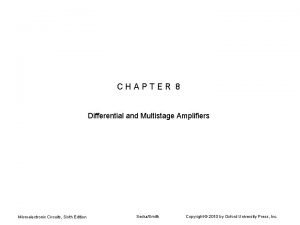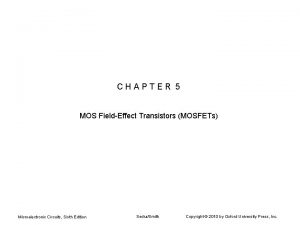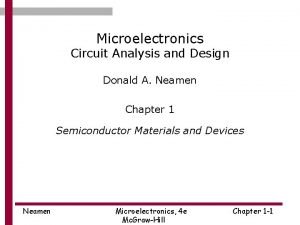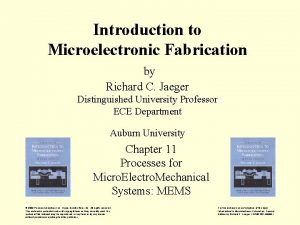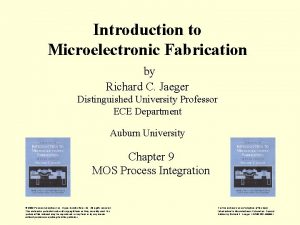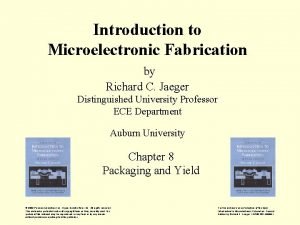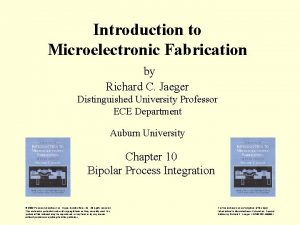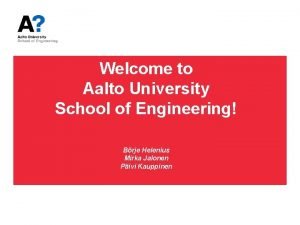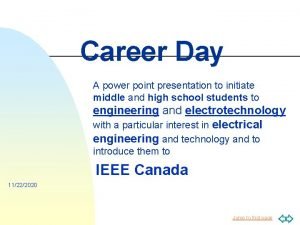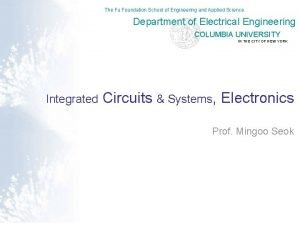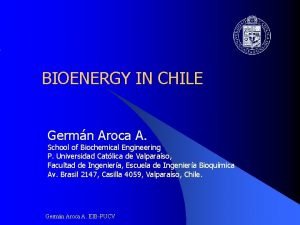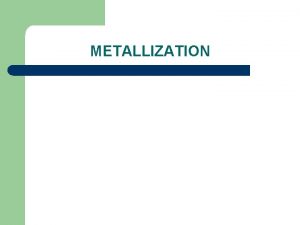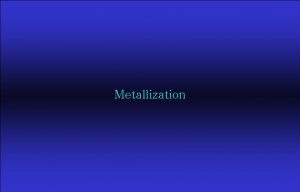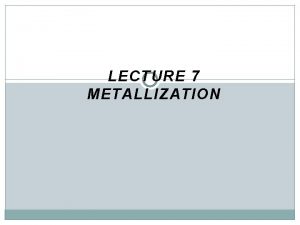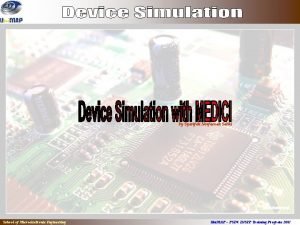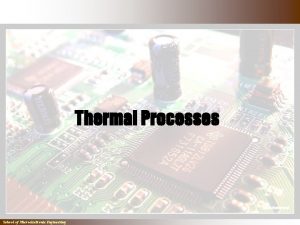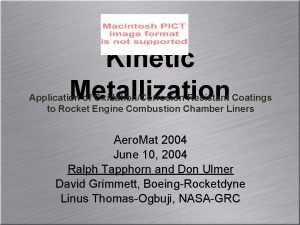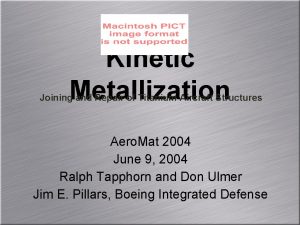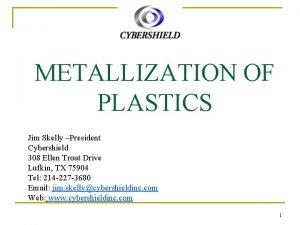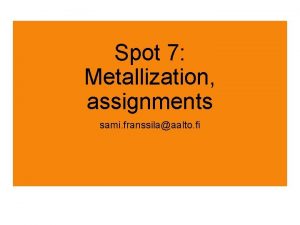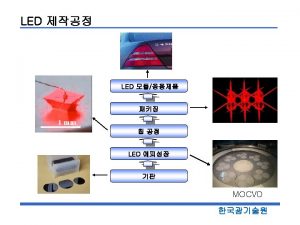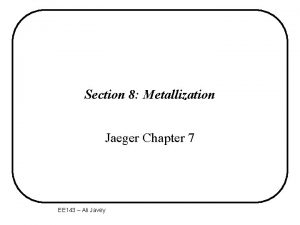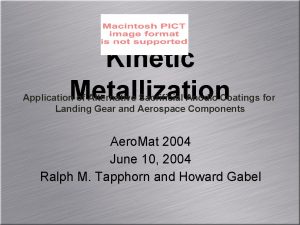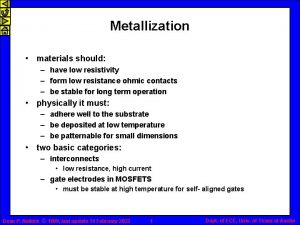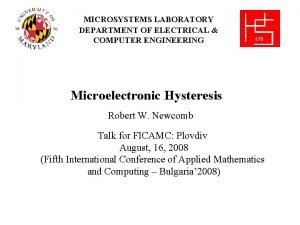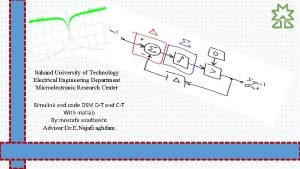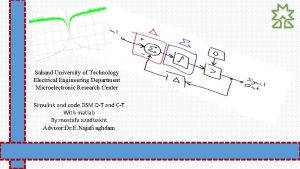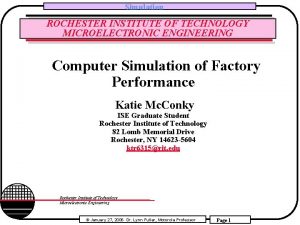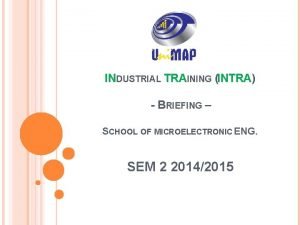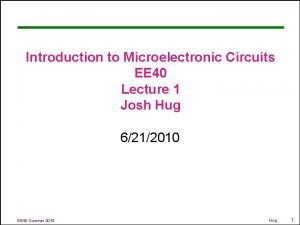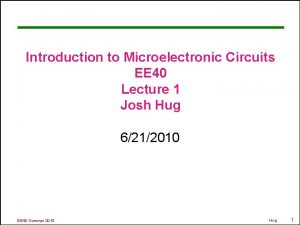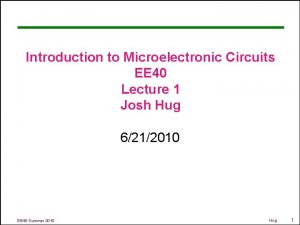Lecture 6 Metallization School of Microelectronic Engineering Summary















































- Slides: 47

Lecture 6 Metallization School of Microelectronic Engineering

Summary of IC Processes ` School of Microelectronic Engineering

Two Types of Thin Film • Dielectric Film (CVD Process) • Oxide • Nitride • Epitaxial silicon • Conducting Film (PVD Process) • Aluminum alloy • Ti, Ti. N • Silicides • Copper (CVD or electroplating) • Tungsten (Metal CVD) • Polysilicon (LPCVD) School of Microelectronic Engineering KUKUM – SHRDC INSEP Training Program 2006

Conducting Thin Film Applications • Front-End-Of-Line (FEOL) • Gate and electrodes • Polysilicon • Polycide • Back-End-Of-Line (BEOL) • Interconnection • Silicides • Barrier • Anti Reflective Coating (ARC) School of Microelectronic Engineering

• Interconnection • Al-Cu alloy is commonly used material School of Microelectronic Engineering

• Interconnection • Copper Metalization – deep submicron School of Microelectronic Engineering

• Silicides • To reduce contact resistance of metal / semiconductor • interface. • Ti. Si 2, WSi 2 and Co. Si 2 are commonly used materials • Self-aligned-silicide-process (SALICIDE) School of Microelectronic Engineering

• Barrier Layer • To prevent aluminum diffusion into silicon (junction-spiking) • Ti. N is widely used barrier material School of Microelectronic Engineering

School of Microelectronic Engineering

• ARC (anti reflective coating) to reduce “notching” during photolithography process. • Ti. N is widely used material School of Microelectronic Engineering

Figure of Merits 1. Step Coverage (Aspect Ratio, Bottom and Sidewall Step Coverage) 2. High Conductivity / Low Resistivity School of Microelectronic Engineering

CVD vs PVD for Metalization CVD: Chemical reaction on the surface PVD: No chemical reaction i. e. purely physical CVD: Better step coverage (50 -100%) and gap-fill capability PVD: Poor step coverage (<15%) and gap-fill capability CVD: Impurities in the film, lower conductivity, hard to deposit alloy. PVD: Purer deposited film, higher conductivity, easy to deposit alloy. School of Microelectronic Engineering

Physical Vapor Deposition (PVD) Process PVD works by vaporizing the solid materials, either by heating or by sputtering, and recondensing the vapor on the substrate to form the solid thin film. School of Microelectronic Engineering

Physical Vapor Deposition (PVD) Process • Evaporation • Thermal Evaporation • Electron Beam Evaporation • Sputtering • Simple DC Sputtering • DC Magnetron Sputtering • DC Triode • RF Diode • RF Triode • RF / DC magnetron School of Microelectronic Engineering

Thermal Evaporation • In the early years of IC manufacturing, thermal evaporation was widely used for aluminum deposition. • Aluminum is relatively easy to vaporized due to low melting point (660 C). School of Microelectronic Engineering

• System needs to be under high vacuum (~ 10 -6 Torr) • Flowing large electric current through aluminum charge heats it up by resistive heating. • Aluminum starts to vaporized • When aluminum vapor reaches the wafer surface, it recondenses and forms a thin aluminum film. School of Microelectronic Engineering

• The deposition rate is mainly related to the heating power, which controlled by the electric current. • The higher the current, the higher the deposition rate. • A significant trace amount of sodium, low deposition rate and poor step coverage. • Difficult to precisely control the proper proportions for the alloy films such as Al: Si, Al: Cu and Al: Cu: Si. • No longer used for metalization processes in VLSI and ULSI School of Microelectronic Engineering

Electron Beam Evaporation • A beam of electrons, typically with the energy about 10 ke. V and current up to several amperes, is directed at the metal in a water-cooled crucible in vacuum chamber. • This process heats the metal to the evaporation temperature. • IR lamp is used to heat the wafer (improve step coverage) School of Microelectronic Engineering

• Better step coverage (higher surface mobility due to lamp heating) • Less sodium contamination (only part of aluminum charge is vaporized. • Cannot match the quality of sputtering deposition, therefore very rarely used in advanced semiconductor fab. School of Microelectronic Engineering

Sputtering • The most commonly used PVD process for metallization • Involves energetic ion bombardment, which physically dislodge atoms or molecules from the solid metal surface, and redeposit them on the substrate as thin metal film. • Argon is normally used as sputtering atom School of Microelectronic Engineering

Sputtering Mechanisme When power is applied between two electrodes under low pressure, a free electron is accelerated by the electric field. When it collides with Ar, another free electron is generated (ionization collision). Ar becomes positively charged i. e glow discharge. The free electron repeat this process to generate more free electrons. DC, RF DC/RF School of Microelectronic Engineering

• The positively charged Ar ions are accelerated toward a negatively biased cathode, usually called target. The target plate is normally made from the same metal that to be deposited on wafer. • When these energetic argon ions hit the target surface, atoms of the target material are physically removed from the surface by the momentum transfer of the impacting ions. School of Microelectronic Engineering

• Sputtered-off atoms leave the target and travel inside the vacuum chamber in the form of metal vapor. • Eventually, some of them reach the wafer surface, adsorb and become so-called adatoms. • The adatoms migrate on the surface until they found nucleation sites and rest there. Other adatoms recondense around the nucleation sites to form grain. • When the grains grow and meet with other grains, they form a continuous poly-crystalline metal thin film on the wafer surface. • The border between grains is called a grain boundary. The grain boundary can scatter electron flows, therefore cause higher resistivity. • Grain size mainly determined by surface mobility, which is related to many other factors School of Microelectronic Engineering

• Normally, higher temperature will result in larger grain size. • Grain size has a strong effect on film reflectivity and sheet resistance. • Film with larger grain size has less grain boundary to scatter electron flow, therefore lower resistivity. School of Microelectronic Engineering

Simple DC Sputtering • The simplest sputtering system. Wafer is placed on on the grounded electrode and the target is the negatively biased electrode, the cathode. • When a high-power DC voltage (several hundred volts) is applied, the argon atoms are ionized by electric field. These accelerate and bombard the target, then sputteredoff the target material from the surface. School of Microelectronic Engineering

DC Magnetron Sputtering • The most popular method for PVD metallization process, because it can achieve high deposition rate, good film uniformity, high film quality, and easy process control. • High deposition rate allow single-wafer processing, which has several advantages over batch-processing. • A rotating magnet is placed on top of metal target. • In a magnetic field, electrons will be constrained near magnetic field line. • This gives electrons more chances for ionization collision. • Therefore, the magnetic field serves to increase plasma density and cause more sputtering near the magnet. School of Microelectronic Engineering

School of Microelectronic Engineering

• By adjusting the location of magnets, the uniformity of the deposited film can be optimized. • Normally, a shield is installed inside the chamber to protect the chamber wall from being deposited. School of Microelectronic Engineering

Sputtering System • • Cluster tool with multiple chamber. Staged vacuum; • Loading station: 10 -6 Torr • Transfer chamber: 10 -7 to 10 -8 Torr • Process chamber: 10 -9 Torr SPUTTER CHAMBER TRNSFORMER /MAIN AC BOX GENERATOR RACK PUMP FRAME SYSTEM CONTROLLER / SYSTEM AC BOX PRE CLEAN COOL DOWN CRYOPUMP COMPRESSOR MAINFRAME ORIENT / DEGAS LOAD LOCK School of Microelectronic Engineering HEAT EXCHANGER

APPLIED MATERIALS, ENDURA HPPVD SYSTEM School of Microelectronic Engineering

Basic Metallization Process Steps • De-gas (Orient/Degas Chamber) • To orient the wafer. • Heat the wafer to drive-out gases and moiture. • Prevent out-gassing during the deposition process School of Microelectronic Engineering

• Pre-Clean (Pre-clean Chamber) • Sputtering etch to remove native oxide on the metal surface. • Prepare contact holes and vias for metal deposition. School of Microelectronic Engineering

Titanium Deposition Process • Normally deposited as welding layer prior to aluminum alloy deposition (reduce contact resistance) • Titanium can trap oxygen and prevent it from bonding with aluminum to form high reistivity aluminum oxide. • To produce larger grain size, wafer is normally heated to 350 C. • Collimated chamber is normally used in deep submicron IC fabrication to achieve better titanium step coverage. School of Microelectronic Engineering

• Collimator allows metal atoms to move in mainly in vertical direction • Significantly improve bottom step coverage School of Microelectronic Engineering

Titanium Nitride Deposition Process • Ti. N is widely used as ARC, glue and barrier layers. • The deposition normally uses a reactive sputtering process. • When nitrogen flows with argon into the process chamber, some nitrogen molecules dissociate as a result of ionization collision. • Free nitrogen radicals are very reactive. They can react with sputtered Ti atoms to form Ti. N and deposit it on the wafer surface. • They can also react with Ti target to form a thin Ti. N layer on the target surface. • Argon bombardment could dislodge Ti. N from the target surface, redeposited on the wafer surface. School of Microelectronic Engineering

School of Microelectronic Engineering KUKUM – SHRDC INSEP Training Program 2006

Al-Cu alloy Deposition Process • • Needs an ultrahigh baseline vacuum to achieve low film resistivity. Standard process • Depositing aluminum alloy over tungsten plug, after Ti and Ti. N wetting layer. • Normally deposited at 200 C, to achieve smaller grain size for better line patterned etch. School of Microelectronic Engineering KUKUM – SHRDC INSEP Training Program 2006

• Hot Aluminum Process • To allow aluminum to fill contact holes and vias, instead of W-plug (CVD) • • This will reduce the contact resistance between metal layers. • Aluminum: ~ 3. 3 Ω. cm • Tungsten: ~ 5. 6 Ω. cm Aluminum is deposited at 450 to 500 C. School of Microelectronic Engineering

Metal Thin Film Measurement / Characterization • Thickness Measurement • Reflectivity • Sheet Resistance • Deposition Rate • Film Stress • Process Uniformity School of Microelectronic Engineering

Thickness Measurement • Metal films such as aluminum, Ti. N and copper are opaque films; therefore, opticalbased technique such as reflectospectrometry cannot be used. • A destructive process is normally required to precisely measure the actual film thickness. School of Microelectronic Engineering

• • • Step height measurement (profilometer) SEM / TEM Four point probe – indirect measurement School of Microelectronic Engineering KUKUM – SHRDC INSEP Training Program 2006

• Accoustic Measurement • Laser shot on thin film surface • Photo-detector measures reflected intensity • Thermal expansion causes a sound wave • Propagates and reflects at interface of different materials • Accoustic wave echoes back and forth • Film thickness can be calculated by; d = Vs ∆t / 2 Vs – speed of sound ∆t - time between reflectivity peaks School of Microelectronic Engineering KUKUM – SHRDC INSEP Training Program 2006

Reflectivity • Reflectivity change indicates a process drift. • A function of film grain size and surface smoothness • Larger grain size, lower reflectivity • Can be measured using Reflectometry (intensity of the reflected beam of light). • Reflectivity measurement results usually use the relative value to silicon. School of Microelectronic Engineering

Sheet Resistance Measurement • Most important characteristics of conducting film. • Widely used to rapidly monitor the deposition process uniformity by indirectly measure the film thickness. • Four Point Probe is commonly used measurement tool School of Microelectronic Engineering

Deposition Rate School of Microelectronic Engineering

Film Stress Measurement • • Stress is due to the mismatch between different materials Compressive stress causes hillock, short between metal Tensile stress causes crack, metal open, peel off Two types of measurement • Contact – profilometer • Non-contact – capacitance measurement School of Microelectronic Engineering

Process Uniformity Max-min uniformity (Max value – Min value) / 2 x average School of Microelectronic Engineering
 Metallization
Metallization Rit microelectronic engineering
Rit microelectronic engineering Microelectronic
Microelectronic Introduction to microelectronic fabrication
Introduction to microelectronic fabrication Jaeger microelectronic circuit design download
Jaeger microelectronic circuit design download Micro electronic pill research paper
Micro electronic pill research paper Sedra
Sedra Microelectronic
Microelectronic Diode load line
Diode load line Jaeger introduction
Jaeger introduction Introduction to microelectronic fabrication jaeger 1990
Introduction to microelectronic fabrication jaeger 1990 Microelectronic circuits
Microelectronic circuits Introduction to microelectronic fabrication jaeger 1990
Introduction to microelectronic fabrication jaeger 1990 Introduction to microelectronic fabrication jaeger 1990
Introduction to microelectronic fabrication jaeger 1990 Microelectronic circuits
Microelectronic circuits 01:640:244 lecture notes - lecture 15: plat, idah, farad
01:640:244 lecture notes - lecture 15: plat, idah, farad Financial engineering notes
Financial engineering notes Software engineering lecture notes
Software engineering lecture notes Foundation engineering lecture notes
Foundation engineering lecture notes Engineering ethics lecture notes
Engineering ethics lecture notes Randy pausch the last lecture summary
Randy pausch the last lecture summary What does reverend cram want the iroquois to do
What does reverend cram want the iroquois to do Computer based system engineering
Computer based system engineering Forward engineering and reverse engineering
Forward engineering and reverse engineering Engineering elegant systems: theory of systems engineering
Engineering elegant systems: theory of systems engineering Elegant systems
Elegant systems Forward and reverse engineering
Forward and reverse engineering Aalto university school of engineering
Aalto university school of engineering Klipsch school of electrical and computer engineering
Klipsch school of electrical and computer engineering Thomas j watson school of engineering acceptance rate
Thomas j watson school of engineering acceptance rate University of belgrade school of electrical engineering
University of belgrade school of electrical engineering Erik jonsson school of engineering and computer science
Erik jonsson school of engineering and computer science Case western reserve university case school of engineering
Case western reserve university case school of engineering Career day presentation
Career day presentation The fu foundation school
The fu foundation school Oussep osaka
Oussep osaka Biochemical engineering school (eib) - pucv valparaíso
Biochemical engineering school (eib) - pucv valparaíso Erik jonsson school of engineering and computer science
Erik jonsson school of engineering and computer science Imperial university summer school
Imperial university summer school Utd erik jonsson school of engineering
Utd erik jonsson school of engineering Project procurement management lecture notes
Project procurement management lecture notes Lecture about sport
Lecture about sport Healthy lifestyle wrap up lecture
Healthy lifestyle wrap up lecture Nihilism vs existentialism
Nihilism vs existentialism Life lecture meaning
Life lecture meaning Tensorflow lecture
Tensorflow lecture Theology proper lecture notes
Theology proper lecture notes Strategic management lecture
Strategic management lecture

